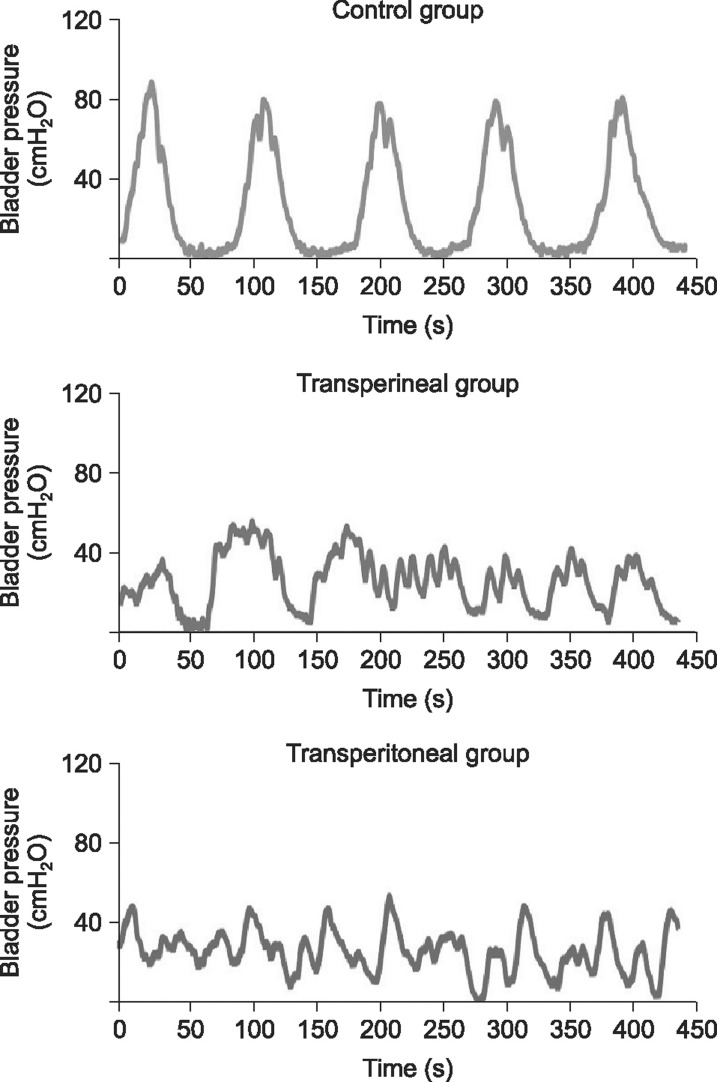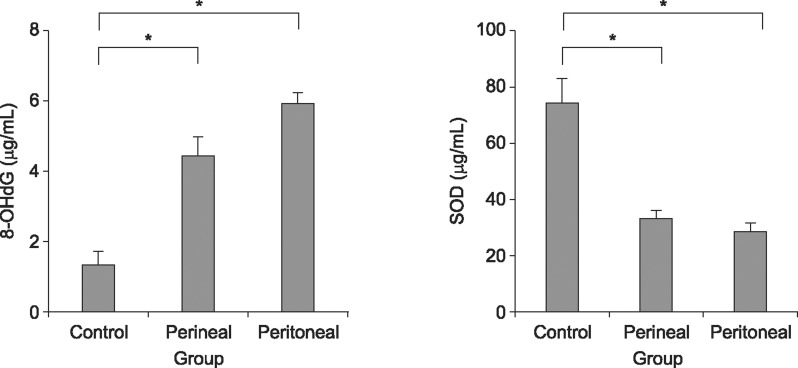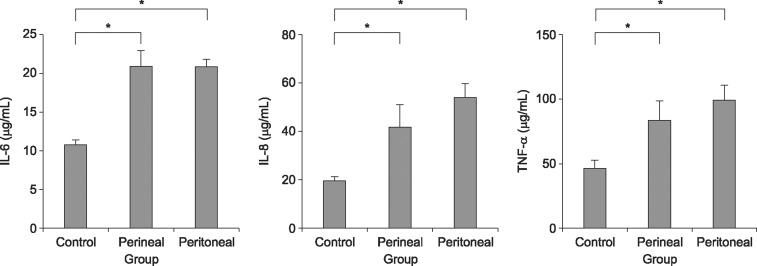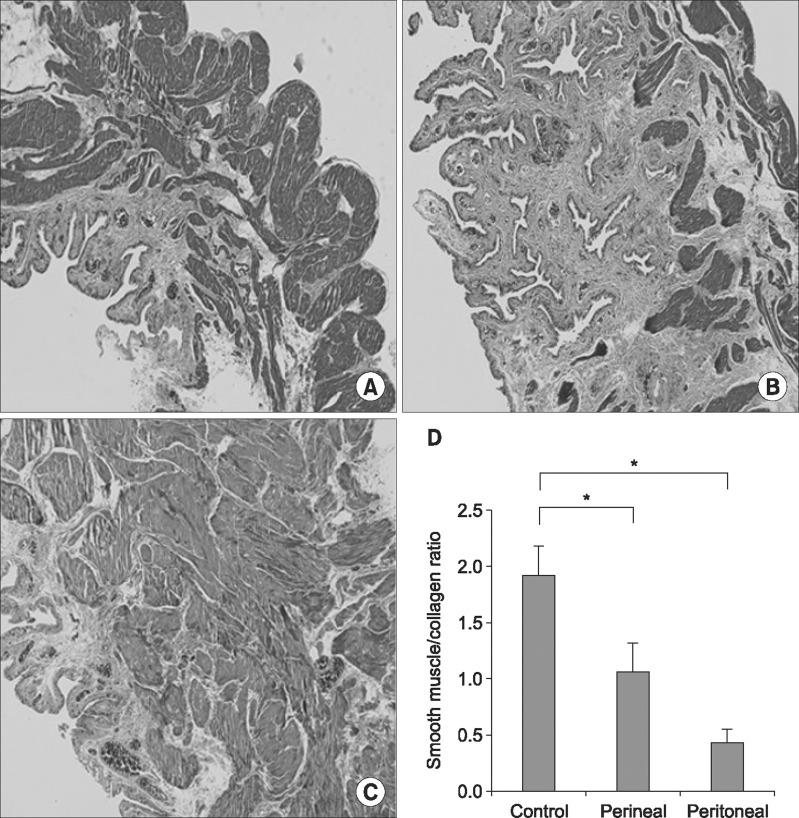World J Mens Health.
2016 Aug;34(2):137-144. 10.5534/wjmh.2016.34.2.137.
Development of an Improved Animal Model of Overactive Bladder: Transperineal Ligation versus Transperitoneal Ligation in Male Rats
- Affiliations
-
- 1Department of Urology, College of Medicine, The Catholic University of Korea, Seoul, Korea. ksw1227@catholic.ac.kr
- 2Catholic Integrative Medicine Research Institute, The Catholic University of Korea, Seoul, Korea.
- 3Korea Bio Medical Science Institute, Seoul, Korea.
- KMID: 2349850
- DOI: http://doi.org/10.5534/wjmh.2016.34.2.137
Abstract
- PURPOSE
We compared a transperineal ligation model and a transperitoneal ligation model in male rats to determine which animal model of overactive bladder (OAB) was more useful based on cystometrography, estimations of oxidative stress, and measurements of pro-inflammatory cytokine levels.
MATERIALS AND METHODS
Male rats were randomly divided into three groups (n=15 in each): the control group, the transperineal ligation group, and the transperitoneal ligation group. Four weeks after the ligation procedure, cystometrography was performed and oxidative stress, pro-inflammatory cytokine levels, and histologic changes were evaluated. Oxidative stress was assessed by measuring 8-hydroxy-20-deoxyguanosine and superoxide dismutase, and pro-inflammatory cytokine activity was investigated by measuring levels of interleukin (IL)-6, IL-8, and tumor necrosis factor-α.
RESULTS
The transperineal model led to results similar to those observed for the transperitoneal model, namely (1) increased voiding frequency and reductions in the non-voiding contraction interval and the maximal vesical pressure, (2) increased levels of oxidative stress markers, (3) increased pro-inflammatory cytokine levels, and (4) fibrotic changes in the bladder tissue.
CONCLUSIONS
We suggest that the transperineal procedure can be used as an alternative OAB model in male rats.
MeSH Terms
Figure
Reference
-
1. Sarma AV, Wei JT, Jacobson DJ, Dunn RL, Roberts RO, Girman CJ, et al. Comparison of lower urinary tract symptom severity and associated bother between communitydwelling black and white men: the olmsted county study of urinary symptoms and health status and the flint men's health study. Urology. 2003; 61:1086–1091. PMID: 12809866.
Article2. Verhamme KM, Dieleman JP, Bleumink GS, van der Lei J, Sturkenboom MC, Artibani W, et al. Incidence and prevalence of lower urinary tract symptoms suggestive of benign prostatic hyperplasia in primary care: the triumph project. Eur Urol. 2002; 42:323–328. PMID: 12361895.3. Berry SJ, Coffey DS, Walsh PC, Ewing LL. The development of human benign prostatic hyperplasia with age. J Urol. 1984; 132:474–479. PMID: 6206240.
Article4. Peters TJ, Donovan JL, Kay HE, Abrams P, de la Rosette JJ, Porru D, et al. The international continence society "Benign Prostatic Hyperplasia" study: the botherosomeness of urinary symptoms. J Urol. 1997; 157:885–889. PMID: 9072592.5. Eckhardt MD, van Venrooij GE, van Melick HH, Boon TA. Prevalence and bothersomeness of lower urinary tract symptoms in benign prostatic hyperplasia and their impact on well-being. J Urol. 2001; 166:563–568. PMID: 11458069.
Article6. Dmochowski RR, Staskin D. Overactive bladder in men: special considerations for evaluation and management. Urology. 2002; 60:56–62. PMID: 12493356.
Article7. Roosen A, Chapple CR, Dmochowski RR, Fowler CJ, Gratzke C, Roehrborn CG, et al. A refocus on the bladder as the originator of storage lower urinary tract symptoms: a systematic review of the latest literature. Eur Urol. 2009; 56:810–819. PMID: 19683859.
Article8. de Nunzio C, Franco G, Rocchegiani A, Iori F, Leonardo C, Laurenti C. The evolution of detrusor overactivity after watchful waiting, medical therapy and surgery in patients with bladder outlet obstruction. J Urol. 2003; 169:535–539. PMID: 12544303.
Article9. Fox C, Smith T, Maidment I, Chan WY, Bua N, Myint PK, et al. Effect of medications with anti-cholinergic properties on cognitive function, delirium, physical function and mortality: a systematic review. Age Ageing. 2014; 43:604–615. PMID: 25038833.10. Gillespie JI. A developing view of the origins of urgency: the importance of animal models. BJU Int. 2005; 96(Suppl 1):22–28. PMID: 16086676.
Article11. Wróbel A, Łańcut M, Rechberger T. A new model of detrusor overactivity in conscious rats induced by retinyl acetate instillation. J Pharmacol Toxicol Methods. 2015; 74:7–16. PMID: 25957030.
Article12. Juszczak K, Ziomber A, Wyczolkowski M, Thor PJ. Urodynamic effects of the bladder C-fiber afferent activity modulation in chronic model of overactive bladder in rats. J Physiol Pharmacol. 2009; 60:85–91. PMID: 20065501.13. Takeda H, Yamazaki Y, Igawa Y, Kaidoh K, Akahane S, Miyata H, et al. Effects of beta(3)-adrenoceptor stimulation on prostaglandin E(2)-induced bladder hyperactivity and on the cardiovascular system in conscious rats. Neurourol Urodyn. 2002; 21:558–565. PMID: 12382247.14. Okutsu H, Matsumoto S, Ohtake A, Suzuki M, Sato S, Sasamata M, et al. Effect of tamsulosin on bladder blood flow and bladder function in a rat model of bladder over distention/emptying induced bladder overactivity. J Urol. 2011; 186:2470–2477. PMID: 22019173.
Article15. Drake M, Gillespie J, Hedlund P, Harvey I, Lagou M, Andersson KE. Muscarinic stimulation of the rat isolated whole bladder: pathophysiological models of detrusor overactivity. Auton Autacoid Pharmacol. 2006; 26:261–266. PMID: 16879491.
Article16. Kato K, Wein AJ, Kitada S, Haugaard N, Levin RM. The functional effect of mild outlet obstruction on the rabbit urinary bladder. J Urol. 1988; 140:880–884. PMID: 3418826.
Article17. Wolffenbuttel KP, Kok DJ, Minekus JP, van Koeveringe GA, van Mastrigt R, Nijman JM. Urodynamic follow-up of experimental urethral obstruction in individual guinea pigs. Neurourol Urodyn. 2001; 20:699–713. PMID: 11746551.
Article18. Mattiasson A, Uvelius B. Changes in contractile properties in hypertrophic rat urinary bladder. J Urol. 1982; 128:1340–1342. PMID: 7154206.
Article19. Zhang NZ, Ma L, Zhang JB, Chen J. Improved model for the establishment and evaluation of detrusor overactivity in female Wistar rats. Int Braz J Urol. 2014; 40:414–421. discussion 422. PMID: 25010309.
Article20. Bae WJ, Ha US, Kim KS, Kim SJ, Cho HJ, Hong SH, et al. Effects of KH-204 on the expression of heat shock protein 70 and germ cell apoptosis in infertility rat models. BMC Complement Altern Med. 2014; 14:367. PMID: 25269420.
Article21. Yoon BI, Bae WJ, Kim SJ, Kim HS, Ha US, Sohn DW, et al. The anti-inflammatory effects of a new herbal formula (WSY-1075) in a nonbacterial prostatitis rat model. World J Mens Health. 2013; 31:150–156. PMID: 24044110.
Article
- Full Text Links
- Actions
-
Cited
- CITED
-
- Close
- Share
- Similar articles
-
- The Role of Intra-abdominal Pressure Measurement in Awake Rat Cystometry
- The Different Mechanisms of Awake Micturitions between Male and Female Rats Using an Overactive Model with Intravesical PGE2 Instillation
- Clinical and Pathological Study After Ligation of Common Carotid Artery in the Rat
- The Value and Limitations of Intravesical Prostaglandin E2 (PGE2)-induced Bladder Hyperactivity as an Overactive Bladder Model in Normal, Conscious Sprague-Dawley Rats
- The Changes of Metabotrophic Glutamate Receptor type 5 in Allodynia Induced by Nerve Ligation






